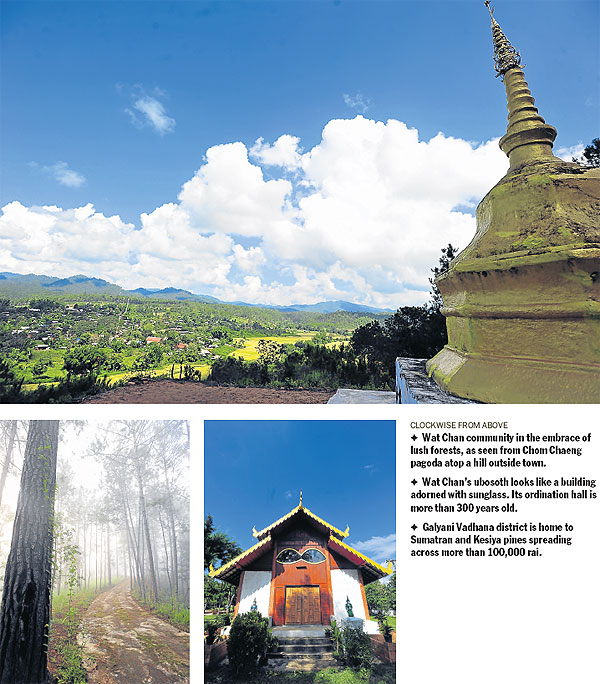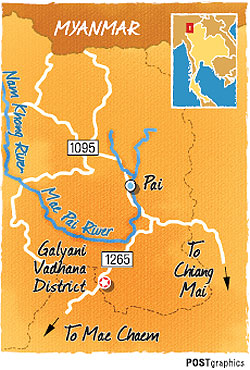Happy valley
Ban Wat Chan in Galyani Vadhana district is blissfully peaceful, for now
- Published: 29/11/2012 at 12:00 AM
If you crave tranquility in the vicinity of Pai,
the vibrant tourist town in northern Mae Hong Son province, Galyani
Vadhana district in neighbouring Chiang Mai is just the place to be.

The road snakes along a winding stream, climbs steep hills and cuts through dense forest. Full of potholes, at times I was forced to drive in the lane opposite, but no need to worry: I didn't cause any traffic jam. During that 90-minute drive on the 60km mountain road leading to Galyani Vadhana district, I spotted only four cars.
It was eerily quiet driving this road, but I found it worthwhile because it presented scenic mountain views of lush green paddies as it weaved its way side by side with a crystal clear steam.
Galyani Vadhana is the newest district of Chiang Mai created four years ago with the objective of presenting it as a responsible and sustainable tourism destination.
Towering pines of the Sumatran and Kesiya varieties _ not seen elsewhere in the country _ grace the road leading to the district, and the trees got bigger as I drew closer to the centre, spreading in every direction as far as the eye could see, filling the air with their unique scent.

TRAVEL INFO
- Galyani Vadhana district is around 170km from Chiang Mai city, and can be reached via Highways 1095 and 1265. Private vehicles are recommended.- Wat Chan Royal Project, run by the Forest Industry Organisation, has clean and nice accommodation with prices starting from 600 baht per night. Call 053-249-349 for more information.
Formerly called Wat Chan, Galyani Vadhana used to be part of larger Mae Chaem district. Karen communities lived on the northern edge of the district which spread for miles in every direction from the town centre. Then, the road link between Wat Chan and Mae Chaem was so poor that Wat Chan residents needing to contact local government agencies preferred driving over 200km via Chiang Mai city to get to Mae Chaem rather than taking the mountain road which was in extremely bad condition, but less than half the distance.
Four years ago Wat Chan was carved out as a new district and renamed after the late HRH Princess Galyani Vadhana, the elder sister of HM the King.
"Land in the district now sells like hot cake. Investors hope the district will turn popular very soon. Already you can find grocery shops, furniture outlets and restaurants rising in the town area. All are operated by outsiders," said Khachit Sutharakorn, the chief of Wat Chan Royal Project.
"Land prices have soared 10-fold even though the plots do not come with ownership documents."
I ambled around and noticed the changes the new district was undergoing. Roads were being built as well as modern offices to house administrative agencies. New businesses were popping up though there was no solid plan for tourism development. Fortunately, these changes were only small. so far.
"Business hasn't been good, actually rather quiet," said Vrapan Yod-ying, owner of newly opened Chan Chao Restaurant in town. A woman from Phrae and her husband, who rode a Harley Davidson, said they closed their business in Pattaya and moved to Wat Chan, hoping a tourism boom would kick-off, but it hasn't arrived yet.
"But the weather is good, very good. Just living here is already proving worthwhile," she said. Sitting at an elevation of 1,000-1,500m above sea level, the district boasts cooler weather than most parts of Thailand, thanks to its over 100,000 rai of pine forests, probably the largest to be found in the country.
The forest has survived because a majority of the people living in the district are Karen who consider trees and forest as part of their lives. In Karen dialect the district is called "Mu Je Key", meaning the origin of the Mae Chaem River. Lush forests and streams in the area are responsible for 40% of water in the Mae Chaem River, one of the major tributaries of the Ping River. Local people also call the place Kor Thor Ti, which translates as "the village at the foot of the pagoda". It is a reference to the first pagoda built in Wat Chan, the nerve centre of the local community for over three centuries.
Every morning, thick fog envelopes the district until late in the day, as if wrapped in a time capsule, and every day passes by slowly and quietly, as if without a care for world beyond it. There is no sense of haste as villagers go about their farms, or carpenters and monks work, renovating the temple building while kids play in the village square, and people remain shy of the camera.
I just hope things stay this way and that this beautiful valley is not compromised by the influx of tourist dollars and modern development.

ไม่มีความคิดเห็น:
แสดงความคิดเห็น